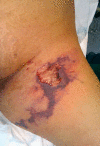Necrotizing fasciitis following saphenofemoral junction ligation with long saphenous vein stripping: a case report
- PMID: 20507621
- PMCID: PMC2887898
- DOI: 10.1186/1752-1947-4-161
Necrotizing fasciitis following saphenofemoral junction ligation with long saphenous vein stripping: a case report
Abstract
Introduction: Necrotizing fasciitis is a rare condition with a mortality rate of around 34%. It can be mono- or polymicrobial in origin. Monomicrobial infections are usually due to group A streptococcus and their incidence is on the rise. They normally occur in healthy individuals with a history of trauma, surgery or intravenous drug use. Post-operative necrotizing fasciitis is rare but accounts for 9 to 28% of all necrotizing fasciitis. The incidence of wound infection following saphenofemoral junction ligation and vein stripping is said to be less than 3%, although this complication is probably under-reported. We describe a case of group A streptococcus necrotizing fasciitis following saphenofemoral junction ligation and vein stripping.
Case presentation: A 39-year-old woman presented three days following a left sided saphenofemoral junction ligation with long saphenous vein stripping at another institution. She had a three day history of fever, rigors and swelling of the left leg. She was pyrexial and shocked. She had a very tender, swollen left groin and thigh, with a small blister anteriorly and was in acute renal failure. She was prescribed intravenous penicillin and diagnosed with necrotizing fasciitis. She underwent extensive debridement of her left thigh and was commenced on clindamycin and imipenem. Post-operatively, she required ventilatory and inotropic support with continuous veno-venous haemofiltration. An examination 12 hours after surgery showed no requirement for further debridement. A group A streptococcus, sensitive to penicillin, was isolated from the debrided tissue. A vacuum assisted closure device was fitted to the clean thigh wound on day four and split-skin-grafting was performed on day eight. On day 13, a wound inspection revealed that more than 90% of the graft had taken. Antibiotics were stopped on day 20 and she was discharged on day 22.
Conclusion: Necrotizing fasciitis is a very serious complication for a relatively minor, elective procedure. To the best of our knowledge, this is the first report in the English-language literature of this complication arising from a standard saphenofemoral junction ligation and vein stripping. It highlights the need to be circumspect when offering patients surgery for non-life-threatening conditions.
Figures



Similar articles
-
Necrotizing fasciitis following postpartum tubal ligation. A case report and review of the literature.Arch Gynecol Obstet. 1995;256(1):35-8. doi: 10.1007/BF00634347. Arch Gynecol Obstet. 1995. PMID: 7726653 Review.
-
Necrotizing fasciitis and streptococcal toxic shock syndrome secondary to varicella in a healthy child.Korean J Pediatr. 2014 Dec;57(12):538-41. doi: 10.3345/kjp.2014.57.12.538. Epub 2014 Dec 31. Korean J Pediatr. 2014. PMID: 25653688 Free PMC article.
-
Randomised controlled study to compare radiofrequency ablation with minimally invasive ultrasound-guided non-flush ligation and stripping of great saphenous vein in the treatment of varicose veins.Ann R Coll Surg Engl. 2020 Sep;102(7):525-531. doi: 10.1308/rcsann.2020.0116. Epub 2020 Jun 15. Ann R Coll Surg Engl. 2020. PMID: 32538106 Free PMC article. Clinical Trial.
-
A fatal case of multidrug resistant acinetobacter necrotizing fasciitis: the changing scary face of nosocomial infection.Case Rep Infect Dis. 2014;2014:705279. doi: 10.1155/2014/705279. Epub 2014 Oct 2. Case Rep Infect Dis. 2014. PMID: 25349748 Free PMC article.
-
Pediatric necrotizing soft tissue infection after elective surgery: A case report and literature review.Int J Pediatr Otorhinolaryngol. 2020 Nov;138:110195. doi: 10.1016/j.ijporl.2020.110195. Epub 2020 Jul 10. Int J Pediatr Otorhinolaryngol. 2020. PMID: 32705989 Review.
Cited by
-
Nicolau's Syndrome Complicated by Atypical Necrotizing Fasciitis.Arch Plast Surg. 2013 May;40(3):267-8. doi: 10.5999/aps.2013.40.3.267. Epub 2013 May 16. Arch Plast Surg. 2013. PMID: 23730607 Free PMC article. No abstract available.
-
Prompt diagnosis and management of cervical necrotizing fascitis.J Clin Diagn Res. 2015 Mar;9(3):ZJ04-5. doi: 10.7860/JCDR/2015/12692.5718. Epub 2015 Mar 1. J Clin Diagn Res. 2015. PMID: 25954723 Free PMC article. No abstract available.
-
Necrotising Fasciitis: Appearances Can Be Deceptive.World J Plast Surg. 2021 Jan;10(1):43-52. doi: 10.29252/wjps.10.1.43. World J Plast Surg. 2021. PMID: 33833953 Free PMC article.
References
-
- Childers BJ, Potyondy LD, Nachreiner R, Rogers FR, Childers ER, Oberg KC, Hendricks DL, Hardesty RA. Necrotizing fasciitis: a fourteen-year retrospective study of 163 consecutive patients. Am Surg. 2002;68:109–116. - PubMed
LinkOut - more resources
Full Text Sources

